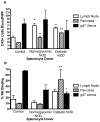Aberrant endometrial features of pregnancy in diabetic NOD mice
- PMID: 17827401
- PMCID: PMC2949414
- DOI: 10.2337/db07-0773
Aberrant endometrial features of pregnancy in diabetic NOD mice
Abstract
Objective: Pregnant diabetic women are at a 4-12 times higher risk for preeclampsia, an urgent acute-onset complication of mid- to late gestation, than normal pregnant women. Hallmarks of preeclampsia are hypertension, proteinuria, and incomplete modification of endometrial spiral arteries. Transient proangiogenic lymphocytes called uterine natural killer (uNK) cells are implicated in human and rodent spiral artery modification. We studied mid- to late gestations in spontaneously type 1 diabetic NOD mice to investigate whether diabetes alters uNK cell homing and/or function.
Research design and methods: Normoglycemic, pre-diabetic, and diabetic NOD mice and controls were mated. Lymphocytes and endometrial endothelium and decidua were studied histologically and in functional assays.
Results: Conception accelerated progression to overt diabetes in NOD females who had limited spiral artery development, heavier placentas, and lighter fetuses displaying numerous birth defects compared with controls. UNK cell numbers were reduced in the decidua basalis of diabetic females, whereas interferon-gamma production was elevated. In diabetic NOD mice, decidual expression of the mucosal vascular addressin cell adhesion molecule (MAdCAM)-1 was aberrant in position, whereas vascular cell adhesion molecule (VCAM)-1 expression was reduced. Assays of lymphocyte adhesion to tissue sections under shear forces indicated that diabetes compromises the potential homing functions of both endometrial endothelium and peripheral NK cells.
Conclusions: In diabetes, gestational endometrium has immune and vascular defects that likely contribute to murine fetal loss and birth defects. Analogous problems and preeclampsia in diabetic women may involve similar mechanisms.
Figures










Similar articles
-
Vascular addressins in the uterus and pancreas of type 1 diabetic mice in early pregnancy.Placenta. 2008 Feb;29(2):201-9. doi: 10.1016/j.placenta.2007.10.003. Epub 2007 Nov 26. Placenta. 2008. PMID: 18031809
-
Circulating CD56+ cells of diabetic women show deviated homing potential for specific tissues during and following pregnancy.Hum Reprod. 2011 Jul;26(7):1675-84. doi: 10.1093/humrep/der114. Epub 2011 Apr 12. Hum Reprod. 2011. PMID: 21489978 Free PMC article.
-
Glucose homeostasis in pre-diabetic NOD and lymphocyte-deficient NOD/SCID mice during gestation.Rev Diabet Stud. 2010 Spring;7(1):36-46. doi: 10.1900/RDS.2010.7.36. Epub 2010 May 10. Rev Diabet Stud. 2010. PMID: 20703437 Free PMC article.
-
Mechanisms regulating immune cell contributions to spiral artery modification -- facts and hypotheses -- a review.Placenta. 2006 Apr;27 Suppl A:S40-6. doi: 10.1016/j.placenta.2005.11.007. Epub 2006 Jan 4. Placenta. 2006. PMID: 16413937 Review.
-
Natural killer cell-triggered vascular transformation: maternal care before birth?Cell Mol Immunol. 2011 Jan;8(1):1-11. doi: 10.1038/cmi.2010.38. Epub 2010 Aug 16. Cell Mol Immunol. 2011. PMID: 20711229 Free PMC article. Review.
Cited by
-
Diabetes consequences in the fetus liver of the non-obese diabetic mice.Nutr Diabetes. 2017 Mar 20;7(3):e257. doi: 10.1038/nutd.2017.7. Nutr Diabetes. 2017. PMID: 28319104 Free PMC article.
-
Maternal Obesity and the Uterine Immune Cell Landscape: The Shaping Role of Inflammation.Int J Mol Sci. 2020 May 27;21(11):3776. doi: 10.3390/ijms21113776. Int J Mol Sci. 2020. PMID: 32471078 Free PMC article. Review.
-
Endometrial receptivity defects and impaired implantation in diabetic NOD mice.Biol Reprod. 2012 Aug 2;87(2):30. doi: 10.1095/biolreprod.112.100016. Print 2012 Aug. Biol Reprod. 2012. PMID: 22539679 Free PMC article.
-
Analysis of maternal and fetal cardiovascular systems during hyperglycemic pregnancy in the nonobese diabetic mouse.Biol Reprod. 2013 Jun 20;88(6):151. doi: 10.1095/biolreprod.112.105759. Print 2013 Jun. Biol Reprod. 2013. PMID: 23636813 Free PMC article.
-
Circulatory and renal consequences of pregnancy in diabetic NOD mice.Placenta. 2011 Dec;32(12):949-55. doi: 10.1016/j.placenta.2011.09.018. Epub 2011 Oct 19. Placenta. 2011. PMID: 22014504 Free PMC article.
References
-
- Leiter EH. The NOD mouse: a model for insulin-dependent diabetes mellitis. Current Protocols in Immunology. 1997;24(suppl):15.9.1–15.9.23. - PubMed
-
- Wicker LS, Clark J, Fraser HI, Garner VE, Gonzalez-Munoz A, Healy B, Howlett S, Hunter K, Rainbow D, Rosa RL, Smink LJ, Todd JA, Peterson LB. Type 1 diabetes genes and pathways shared by humans and NOD mice. J Autoimmun. 2005;25 (Suppl):29–33. - PubMed
-
- Wicker LS, Todd JA, Peterson LB. Genetic control of autoimmune diabetes in the NOD mouse. Annu Rev Immunol. 1995;13:179–200. - PubMed
-
- Serreze DV, Leiter EH. Defective activation of T suppressor cell function in nonobese diabetic mice. Potential relation to cytokine deficiencies. J Immunol. 1988;140:3801–3807. - PubMed
Publication types
MeSH terms
Substances
Grants and funding
LinkOut - more resources
Full Text Sources
Medical
Molecular Biology Databases
Miscellaneous

